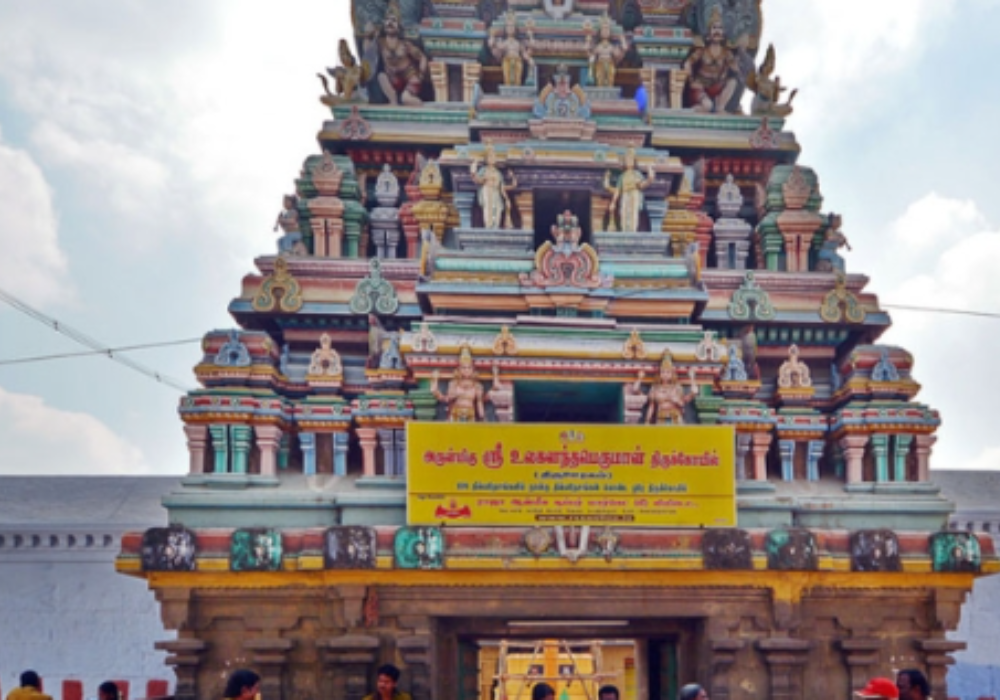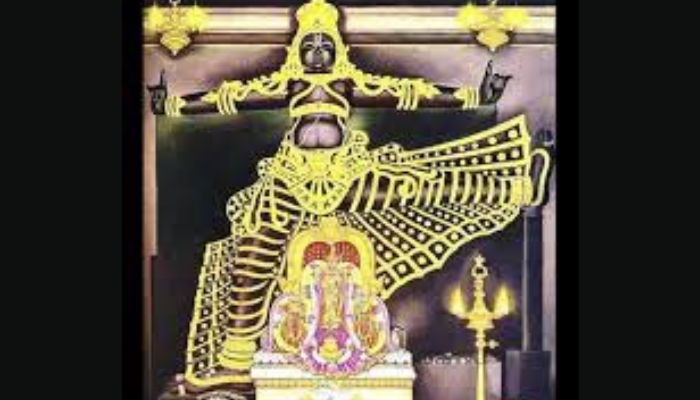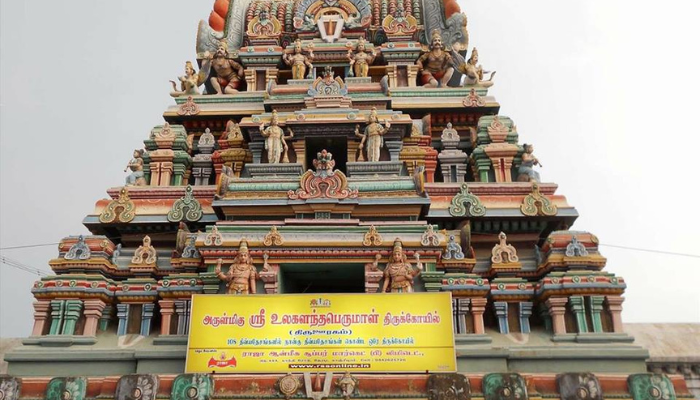
Nestled in the heart of Kanchipuram, Tamil Nadu, the Ulagalantha Perumal Temple Kanchipuram stands as a magnificent testament to ancient Dravidian architecture and profound spiritual heritage. This revered sanctuary is not just a place of worship; it is a living chronicle of myths, history, and devotion. Dedicated to Lord Vishnu, specifically in his awe-inspiring Trivikrama form, this temple offers a unique spiritual experience. Pilgrims and history enthusiasts alike are drawn to its sacred precincts, eager to explore its intricate carvings and understand the deep spiritual narratives it holds. Furthermore, the temple is celebrated as one of the 108 Divya Desams, which are the holy abodes of Vishnu praised by the revered Alvars, making it incredibly significant for devotees. Indeed, the Ulagalantha Perumal Temple Kanchipuram in Tamil culture holds a special place, echoing tales of cosmic power and divine grace.
The Cosmic Legend of Vamana: A Tale of Humility and Divine Power

The very essence of the Ulagalantha Perumal Temple Kanchipuram is deeply intertwined with the captivating legend of Lord Vishnu’s Vamana avatar. This profound story, recounted in ancient Hindu scriptures like the Bhagavata Purana, serves as the central narrative for the temple’s main deity. It tells of a time when the benevolent Asura king Mahabali, through his immense power and generosity, had gained dominion over all three worlds: heaven, earth, and the netherworld. However, his growing pride threatened the cosmic balance. Therefore, Lord Vishnu decided to intervene, not through force, but through a display of subtle power and humility.
Vishnu took the form of Vamana, a diminutive Brahmin dwarf carrying a humble wooden umbrella and a water pot. Approaching King Mahabali during a grand yajna (ritual sacrifice), Vamana requested a seemingly modest favor: three paces of land. Mahabali, known for his generosity, readily agreed to this request, despite warnings from his guru, Shukracharya, who recognized Vamana’s true divine nature.
The Three Steps That Measured the Universe
Upon receiving Mahabali’s consent, Vamana underwent a miraculous transformation. He expanded into the colossal form of Trivikrama, a cosmic giant whose form stretched across the entire universe. With his first earth-shattering stride, Trivikrama covered all of heaven. His second mighty step encompassed the entire earth and all its dominions. With two worlds measured, no space remained for the third step. Mahabali, witnessing this awe-inspiring sight and realizing Vamana’s true identity as Lord Vishnu, humbly offered his own head as the place for the third step. Lord Vishnu, in his Trivikrama form, then placed his foot upon Mahabali’s head, pushing him down to the netherworld (Patala Loka). Some accounts suggest that Vamana, touched by Mahabali’s humility, granted him dominion over this netherworld realm. This legendary duel between humility and pride, culminating in Vishnu’s cosmic display, is eternally etched within the very walls of the Ulagalantha Perumal Temple Kanchipuram.
Architectural Grandeur: A Dravidian Masterpiece

The Ulagalantha Perumal Temple Kanchipuram is a stunning example of the Dravidian style of architecture, renowned for its towering gopurams, intricate carvings, and vast courtyards. Spanning an impressive area of approximately 60,000 square feet, this temple complex showcases the architectural prowess of various dynasties that contributed to its development over centuries. The temple features a magnificent three-tiered rajagopuram, the main entrance tower, adorned with seven kalasas (finials) at its peak, immediately captivating visitors with its grandeur. The overall design of the temple, with its colossal pavilions and detailed sculptures, truly reflects the rich artistic traditions of South India.
The central deity, Lord Ulagalantha Perumal, is depicted in a truly unique and imposing manner. His idol stands at an astonishing height of nearly 35 feet, making it one of the largest Vishnu idols in existence. This grand statue portrays the cosmic moment of his three strides. His right leg is firmly placed on the ground, while his left leg is raised high, almost perpendicular to his body, symbolizing the momentous second step that covered the celestial realms. The Lord’s left hand often shows two stretched fingers, indicating the two worlds he measured, while his right hand, with one finger extended, points to the question posed to Mahabali about the third step. The sheer scale and intricate detailing of the idol deeply captivate every devotee who enters the temple.
Inscriptions and Historical Footprints
The history of the Ulagalantha Perumal Temple Kanchipuram is etched in its numerous inscriptions, offering valuable insights into its evolution and the dynasties that patronized it. According to renowned historian Nagaswamy, based on these inscriptions and the temple’s location, it is considered the oldest temple in Kanchipuram. The earliest recorded inscription dates back to 846 CE, during the reign of Nandivarman III, a Pallava king. Successive powerful dynasties, including the Pallavas, medieval Cholas, Vijayanagara kings, and Madurai Nayaks, have left their indelible mark on the temple, contributing to its expansion and renovation. There are as many as 15 significant inscriptions detailing the temple’s development over centuries. These historical records also reveal insights into the socio-economic life of the period, including details about trade and commerce, with licenses provided for various shops.
A Unique Abode: Four Divya Desams in One
One of the most remarkable and unique features of the Ulagalantha Perumal Temple Kanchipuram is that it houses not one, but four separate Divya Desams within its complex. These sacred shrines, believed to have once been independent temples, are Thirukkarvaanam, Thirukaaragam, Thiruneeragam, and Tiruooragam. The reason for their unification under one roof remains shrouded in history, yet this unique arrangement makes the Ulagalantha Perumal Temple unparalleled among the 108 Divya Desams. This extraordinary feature allows devotees to offer prayers at multiple highly revered Vishnu shrines within a single visit, enriching their spiritual journey.
The Significance of Each Inner Shrine
Each of the four Divya Desams housed within the Ulagalantha Perumal Temple Kanchipuram carries its own unique significance and presiding deity. Tiruooragam is the central and main shrine within the complex, housing the image of Adisesha, the serpent god. Legend has it that King Mahabali, unable to fully comprehend Vishnu’s cosmic form, requested a smaller manifestation. Vishnu then appeared as a serpent in this very shrine, and devotees, especially couples seeking children, frequently visit this sacred space for blessings.
Thirukkarvaanam is another important shrine within the complex. Its presiding deity is Thirukkaar Vaanar. The name “Kaar” signifies clouds, and the deity here is believed to represent the cosmic presence of water and clouds, vital elements of the universe. This shrine emphasizes the Lord’s omnipresence in nature’s fundamental forces.
The Thirukaaragam shrine is located in the third precinct of the temple. According to Hindu legend, Sage Garga performed his penance here and attained profound knowledge, leading to the place being named Karagaham, which later became Karakam. The presiding deity here is Karunakara Perumal, facing north, seated on Adisesha, alongside his consort Padmamani Nachiyar. The temple tank associated with this shrine is known as Agraya Tirtham.
Finally, Thiruneeragam is another Divya Desam located within the Ulagalantha Perumal Temple. The main deity here is Sri Neeragathan, also known as Jagadeeshwarar, who is found in a standing posture facing east. He is accompanied by Nilamangai Valli Thaayar. This shrine is believed to be where Markandeya Maharishi performed penance, seeking a vision of “Aalilai Krishnan,” the child Krishna resting on a banyan leaf. The Alvars, particularly Thirumangai Alvar, have sung praises of all these four temples in a single verse, highlighting their collective spiritual importance.
Spiritual Vibrancy: Rituals and Reverence at Ulagalantha Perumal Temple Kanchipuram
The Ulagalantha Perumal Temple Kanchipuram is not merely an architectural marvel; it is a vibrant center of continuous devotion and spiritual activity. Vaishnavaite Brahmin priests meticulously conduct six elaborate daily pujas (rituals), enveloping the temple in an aura of Vedic chants, fragrant incense, and the resonant tones of traditional musical instruments like the nagaswaram (pipe instrument) and tavil (percussion instrument). These daily rituals are integral to the temple’s spiritual life, ensuring a constant connection with the divine.
Each of the six daily rituals follows a specific three-step process: alangaram (decoration of the deity), neivethanam (offering of food), and deepa aradanai (waving of lamps). These steps symbolize the communion between the devotee and the divine, and the dispelling of darkness through spiritual light. The daily puja timings are Ushathkalam at 7:00 AM, Kalasanthi at 8:00 AM, Uchikalam at 12:00 PM, Sayarakshai at 6:00 PM, Irandamkalam at 7:00 PM, and Ardha Jamam at 10:00 PM. These structured rituals imbue the temple with a dynamic and palpable spiritual energy, drawing devotees into a profound experience of faith.
Celebrating Divinity: Major Festivals
The vibrancy of the Ulagalantha Perumal Temple Kanchipuram reaches its peak during its numerous festivals, which attract thousands of devotees from all corners of the world. Two major festivals are particularly prominent: Brahmotsavam and Vamana Jayanthi. The Brahmotsavam is celebrated during the Tamil month of Thai (January-February) and features grand processions where the deity is carried, allowing devotees to relive the celestial events. This festival is a spectacle of devotion and cultural richness.
Vamana Jayanthi, celebrating the birth of Lord Vamana, is observed during the Tamil month of Avani (August-September) on the Sravanam star. This festival directly commemorates the central legend of the temple. Additionally, the chariot festival, celebrated during the Tamil month of Chittirai (March-April), is another highly prominent event. Vaikunta Ekadasi, celebrated in the Tamil month of Margazhi (mid-December to mid-January), also draws a large number of devotees. Moreover, the temple is known for special pujas like the Naga Dosha or Kaal Sarpa Dosha Pooja, which are performed to alleviate specific astrological afflictions.
Planning Your Pilgrimage to Ulagalantha Perumal Temple Kanchipuram
Visiting the Ulagalantha Perumal Temple Kanchipuram offers a deeply enriching experience, blending spiritual solace with historical exploration. The temple is conveniently located in Big Kanchipuram, very close to the famous Kamakshi Amman Temple, making it easily accessible for visitors. Its proximity to other significant temples in Kanchipuram allows for a comprehensive pilgrimage itinerary.
The temple generally operates with specific timings to accommodate daily rituals and devotees. It is open from 6:00 AM to 12:00 PM and then reopens from 4:00 PM to 8:00 PM. However, it is always advisable to verify these timings, as they may vary on special occasions or during major festivals. There is no entry fee to visit the temple. Photography is generally not allowed inside the temple, preserving its sanctity.
Navigating Kanchipuram: A City of Temples
Kanchipuram, often celebrated as the “City of Thousand Temples,” is a delightful destination for pilgrims and tourists alike. The best time to visit the Ulagalantha Perumal Temple Kanchipuram and the city in general is during the winter months, from October to March when the weather is most pleasant for sightseeing. This period also often coincides with major festivals, offering a more vibrant experience. While the city is well-connected by rail, the nearest airport is in Chennai, approximately two hours away.
Beyond its spiritual significance, Kanchipuram is globally renowned for its exquisite silk sarees. Therefore, a visit to the city would be incomplete without exploring the local markets and witnessing the traditional art of silk weaving. The local cuisine, predominantly South Indian and vegetarian, offers a delightful culinary experience. Many hotels and guesthouses are available near the temple for comfortable accommodation. Planning your visit during weekdays can help avoid larger crowds, ensuring a more peaceful experience at the temples.
The Enduring Legacy of Ulagalantha Perumal Temple Kanchipuram in Tamil Culture
The Ulagalantha Perumal Temple Kanchipuram holds an especially cherished place in Tamil culture and religious history. Its glorification in the Naalayira Divya Prabandham, an early medieval Tamil text composed by the Alvar saints between the 6th and 9th centuries CE, underscores its profound spiritual importance. These hymns, particularly those by Thirumangai Alvar and Thirumazhisai Alvar, beautifully encapsulate the temple’s essence and the divine attributes of Ulagalantha Perumal. The temple’s presence in such revered texts solidifies its status as a cornerstone of Vaishnavite tradition in Tamil Nadu.
The very name, Ulagalantha Perumal Temple Kanchipuram in Tamil, directly translates to “the Lord who measured the world,” resonating deeply with the local populace and reinforcing the central legend of Vishnu’s cosmic strides. The architectural style, daily rituals, and festive celebrations all reflect the rich cultural tapestry of the region. The temple serves as a continuous reminder of ancient wisdom, humility, and the boundless power of the divine, deeply influencing the spiritual landscape of Tamil Nadu. Its enduring legacy is a testament to the unwavering faith and artistic brilliance of generations.
Frequently Asked Questions (FAQ) about Ulagalantha Perumal Temple Kanchipuram
What is the Ulagalantha Perumal Temple Kanchipuram?
The Ulagalantha Perumal Temple Kanchipuram is a highly revered Hindu temple dedicated to Lord Vishnu, located in Kanchipuram, Tamil Nadu, India. It is particularly famous for housing one of the largest idols of Lord Vishnu in his Trivikrama form, depicting his cosmic strides.
What is the significance of Ulagalantha Perumal Temple?
This temple is one of the 108 Divya Desams, which are sacred abodes of Lord Vishnu mentioned in the Naalayira Divya Prabandham. It is uniquely significant because it houses four different Divya Desams (Tirukkaravanam, Tirukarakam, Thiruneeragam, and Tiruooragam) within its complex.
What is the legend associated with Ulagalantha Perumal Temple Kanchipuram?
The temple is associated with the legend of Lord Vishnu’s Vamana avatar. In this story, Vishnu, as a dwarf Brahmin named Vamana, requested three paces of land from King Mahabali. Vamana then expanded into the colossal Trivikrama form, covering the universe in two strides and placing his third step on Mahabali’s head, sending him to the netherworld.
What are the temple timings for Ulagalantha Perumal Temple Kanchipuram?
The temple is generally open for devotees from 6:00 AM to 12:00 PM in the morning and from 4:00 PM to 8:00 PM in the evening. However, timings may vary during special festivals or occasions.
Which festivals are celebrated at Ulagalantha Perumal Temple?
Major festivals celebrated at the temple include Brahmotsavam (January-February), Vamana Jayanthi (August-September), and the Chariot festival (March-April). Vaikunta Ekadasi is also an important festival here.
Who built the Ulagalantha Perumal Temple Kanchipuram?
The temple is believed to have been initially built during the Pallava period, with significant contributions and renovations by later dynasties such as the medieval Cholas, Vijayanagara kings, and Madurai Nayaks. Inscriptions indicate construction during the reign of Nandivarman III (846-869 CE).
What is special about the main idol at Ulagalantha Perumal Temple?
The main idol of Lord Ulagalantha Perumal (Trivikrama) is approximately 35 feet tall, making it one of the largest Vishnu idols. It depicts Lord Vishnu with one foot on the ground and the other raised high, symbolizing his cosmic strides that measured the universe.
Are there other temples located nearby Ulagalantha Perumal Temple Kanchipuram?
Yes, the Ulagalantha Perumal Temple Kanchipuram is situated very close to the famous Kamakshi Amman Temple. Other significant temples in Kanchipuram, such as Ekambareswarar Temple and Varadharaja Perumal Temple, are also easily accessible.
Is photography allowed inside the Ulagalantha Perumal Temple?
Generally, photography is not permitted inside the Ulagalantha Perumal Temple Kanchipuram to maintain its sanctity.
What is the meaning of Ulagalantha Perumal in Tamil?
In Tamil, “Ulagalantha Perumal” (உலகளந்த பெருமாள்) translates to “the Lord who measured the world” or “the Lord who measured the universe,” directly referring to Lord Vishnu’s Trivikrama form.
Conclusion
The Ulagalantha Perumal Temple Kanchipuram truly stands as a monumental emblem of devotion, architectural brilliance, and profound spiritual narratives. Its towering gopurams and the magnificent 35-foot idol of Lord Vishnu in his Trivikrama form immediately capture the imagination, inviting visitors into a realm where myth and history intertwine. This unique temple, which remarkably houses four Divya Desams within its sacred precincts, offers an unparalleled pilgrimage experience, allowing devotees to connect with multiple facets of Lord Vishnu’s divine presence.
From the ancient inscriptions that narrate its origins during the Pallava era to the vibrant daily rituals and grand festivals that continue to draw thousands, the Ulagalantha Perumal Temple Kanchipuram remains a living testament to an enduring faith. It serves not only as a place of worship but also as a cultural beacon, deeply rooted in the rich traditions of Tamil Nadu and celebrated in revered Tamil literature like the Naalayira Divya Prabandham. A visit to this temple offers more than just a glimpse into religious practices; it provides a deep dive into the cosmic dance of humility, power, and divine justice, leaving an indelible mark on the hearts of all who step into its hallowed grounds.

Binu Lamba
Binu Lamba is a 29-year-old editor and fact-checker with 7 years of experience in travel content. He verifies all location details, hotel recommendations, and travel tips to ensure our guides are accurate, updated, and helpful for readers planning real trips.

AI Assistant
Our AI writing assistant supports the creation of travel content under strict human supervision. All AI-generated posts are thoroughly reviewed, fact-checked, and updated by our team to maintain trust and accuracy in our travel recommendations.

“Jaipur Weather: Monthly Guide to Temperatures and Climate”
Planning a trip or just curious about Jaipur weather? This guide will walk you through the month-by-month weather in Jaipur, Rajasthan so you can plan

Hotels in Ahmedabad: Your Ultimate Guide to the Best Stays in 2025
Planning a trip and looking for hotels in Ahmedabad? Whether you’re here for business or to explore the city’s rich culture, there’s a wide range

The Ultimate Guide to Finding the Best Cafe in Ahmedabad for Coffee, Food, and Fun
Welcome to Ahmedabad, a city where tradition and modernity blend seamlessly. This vibrant metropolis is not just about historical sites and bustling markets. It is








